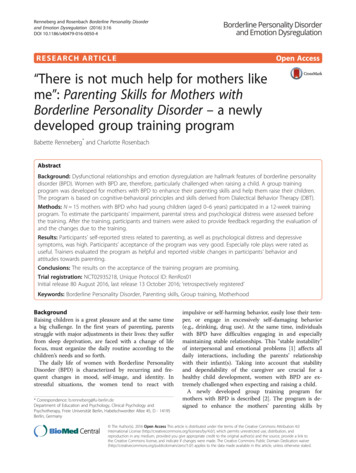
Transcription
Renneberg and Rosenbach Borderline Personality Disorderand Emotion Dysregulation (2016) 3:16DOI 10.1186/s40479-016-0050-4RESEARCH ARTICLEOpen Access“There is not much help for mothers likeme”: Parenting Skills for Mothers withBorderline Personality Disorder – a newlydeveloped group training programBabette Renneberg* and Charlotte RosenbachAbstractBackground: Dysfunctional relationships and emotion dysregulation are hallmark features of borderline personalitydisorder (BPD). Women with BPD are, therefore, particularly challenged when raising a child. A group trainingprogram was developed for mothers with BPD to enhance their parenting skills and help them raise their children.The program is based on cognitive-behavioral principles and skills derived from Dialectical Behavior Therapy (DBT).Methods: N 15 mothers with BPD who had young children (aged 0–6 years) participated in a 12-week trainingprogram. To estimate the participants’ impairment, parental stress and psychological distress were assessed beforethe training. After the training, participants and trainers were asked to provide feedback regarding the evaluation ofand the changes due to the training.Results: Participants’ self-reported stress related to parenting, as well as psychological distress and depressivesymptoms, was high. Participants’ acceptance of the program was very good. Especially role plays were rated asuseful. Trainers evaluated the program as helpful and reported visible changes in participants’ behavior andattitudes towards parenting.Conclusions: The results on the acceptance of the training program are promising.Trial registration: NCT02935218, Unique Protocol ID: RenRos01Initial release 80 August 2016, last release 13 October 2016; ‘retrospectively registered’Keywords: Borderline Personality Disorder, Parenting skills, Group training, MotherhoodBackgroundRaising children is a great pleasure and at the same timea big challenge. In the first years of parenting, parentsstruggle with major adjustments in their lives: they sufferfrom sleep deprivation, are faced with a change of lifefocus, must organize the daily routine according to thechildren’s needs and so forth.The daily life of women with Borderline PersonalityDisorder (BPD) is characterized by recurring and frequent changes in mood, self-image, and identity. Instressful situations, the women tend to react with* Correspondence: b.renneberg@fu-berlin.deDepartment of Education and Psychology, Clinical Psychology andPsychotherapy, Freie Universität Berlin, Habelschwerdter Allee 45, D - 14195Berlin, Germanyimpulsive or self-harming behavior, easily lose their temper, or engage in excessively self-damaging behavior(e.g., drinking, drug use). At the same time, individualswith BPD have difficulties engaging in and especiallymaintaining stable relationships. This “stable instability”of interpersonal and emotional problems [1] affects alldaily interactions, including the parents’ relationshipwith their infant(s). Taking into account that stabilityand dependability of the caregiver are crucial for ahealthy child development, women with BPD are extremely challenged when expecting and raising a child.A newly developed group training program formothers with BPD is described [2]. The program is designed to enhance the mothers’ parenting skills by The Author(s). 2016 Open Access This article is distributed under the terms of the Creative Commons Attribution 4.0International License (http://creativecommons.org/licenses/by/4.0/), which permits unrestricted use, distribution, andreproduction in any medium, provided you give appropriate credit to the original author(s) and the source, provide a link tothe Creative Commons license, and indicate if changes were made. The Creative Commons Public Domain Dedication o/1.0/) applies to the data made available in this article, unless otherwise stated.
Renneberg and Rosenbach Borderline Personality Disorder and Emotion Dysregulation (2016) 3:16teaching them about the primary needs of the child, coping with stress, emotion regulation, and self-care.Mothers with BPDThe existing literature points to the numerous difficulties mothers with BPD face (for an overview see [3]).Compared to clinical and non-clinical control groups,the level of parental depression is elevated in samples ofmothers with BPD; they engage more often in alcoholand drug abuse and show suicidal behavior [4, 5].Mothers with BPD often have difficulties in accuratelyperceiving and reacting to their own emotional needs.Therefore, findings demonstrating the difficulty ofmothers with BPD to respond sensitively to their infant’sneeds are not surprising (e.g. [6]). By analyzing theirspeech and behavior in the interaction with their offspring, mothers with BPD were characterized as intrusive and insensitive [7]. Compared to a healthy controlgroup, mothers with BPD showed more affective dysregulation in the communication with their children as wellas more critical and intrusive behaviors, role confusion,and frightened/frightening behaviors [8]. Additionally, areduced ability of mothers with BPD to think about theirchildren’s mental state (“mind-mindedness”) comparedto healthy controls was observed [9].Mothers with BPD were more inclined to inhibit autonomy and relatedness in their teenaged children thana group of healthy mothers, whereby this inhibition tendency of the mothers was associated with adolescent internalizing and externalizing symptoms [10]. Regardingmother-infant interaction and parenting perceptions,mothers with BPD reported lower levels of maternalself-esteem, competence and satisfaction, higher distressand less structure in their interaction with their offspringthan a healthy control group [6].In their attachment patterns, mothers with BPD weresignificantly more likely to be classified as insecure, preoccupied, and unresolved than a normative comparisongroup [11]. Children’s disruptions in attachment (e.g.,fear of abandonment and role reversal) and selfregulation were associated to their mothers’ preoccupiedand unresolved attachment style. The significance of roleconfusion for the development of mental distress in children and adolescents has recently been highlighted byMacfie and colleagues [12].In addition to the mental health problems of motherswith BPD, there are numerous other stressors, mostlysocial strains the mothers have to deal with, e.g., being asingle parent, having low social support in the family,changing partners, instable households (e.g. [4]).Children of mothers with BPDA mental disorder of one or both parents is a general riskfactor for psychological distress in children (e.g. [13]).Page 2 of 7Children of mothers with BPD have a higher prevalence ofemotional and behavioral problems than children ofhealthy mothers as well as children of mothers with othermental disorders [14–16].In the following, empirical evidence for the difficultiesand problems children of mothers with BPD have issummarized based on the age of the children. Emotionaldysregulation starts early in children of mothers withBPD. Using the still-face paradigm, Crandell et al. [17]observed less responsiveness in children of mothers withBPD toward their mother than infants of mothers without a mental disorder. One year later, 80% of this sampleshowed disorganized attachment behavior towards theirmothers [7]. Two studies indicate that the reunion episode of the still-face paradigm seems particularly challenging for the dyads [17, 18]. Mothers showed fewersmiles than mothers of the control group and an increase in intrusive behavior. Their children in turnexpressed less positive phonation [18] and more negativeaffect than infants of mothers with no psychopathology.The children also took longer to reengage with theirmothers [17].In a free-play interaction, infants of mothers withBPD were less attentive and less interested in interactions with their mother compared to children ofhealthy mothers [6]. In a recent study, maternal BPDsymptoms were related to either very high or verylow but less to moderate levels of fear in 12- to 23month-old infants, indicating disturbed levels of children’s fear expression [19].Regarding psychopathology and mental disorders inschool-aged and adolescent children of mothers withBPD, this population showed more disruptive behavior,more Attention Deficit/Hyperactivity Disorder (ADHD)and more borderline symptoms than children of healthymothers [4, 20]. They tend to have higher levels of anxiety and depression, and significantly lower self-esteemcompared to children of healthy mothers and childrenof mothers with depressive disorder and cluster C personality disorders [15]. In a story completion task, 4–7year-old children of mothers with BPD showed pooreremotion regulation, more role reversal, greater fear ofabandonment, more negative parent-child relationship,as well as more incongruent and shameful selfrepresentations than a healthy control group [21]. In alarge community sample, maternal BPD symptoms wereassociated with poorer psychosocial functioning in adolescents (e.g., lower social self-perception) as well as withhigher and chronic stress in the mother-adolescent relationship, and greater maternal hostility [16]. Reinelt andcolleagues [22] investigated 15-year old adolescents andfound that particularly an overprotective and rejectingparenting style as well as discrepancies in the perceptionof psychopathological problems of the offspring mediate
Renneberg and Rosenbach Borderline Personality Disorder and Emotion Dysregulation (2016) 3:16the longitudinal transmission of borderline symptomsfrom mother to child 5 years later.In summary, children of mothers with BPD have agreater risk for emotional and behavioral problems thanchildren of healthy mothers or children of mothers withother mental disorders such as depression. Especially inearly childhood, the maternal behavior is crucial for thedevelopment of personal needs, attachment patterns,identity, and interpersonal behavioral strategies. We,therefore, aimed to conceptualize a training program formothers with BPD to enhance their parental skills andfacilitate a healthy child development.Page 3 of 7to point to the importance of mindfulness in the interaction with children to better perceive and understandthe needs of the children and to gain a greater controlover own dysfunctional behavior impulses.Children’s basic needsMothers with BPD often show a lack of knowledgeabout the basic (emotional) needs (e.g., to feel safe) ofchildren. The third session provides an overview regarding children’s needs, and the women are encouraged toassess their own competences to satisfy these needs.Stress and stress managementThe training program “Parenting Skills for Motherswith Borderline Personality Disorder”Parenting Skills for Mothers with Borderline PersonalityDisorder consists of 12 weekly sessions that are held bytwo female trainers experienced in working with patientswith BPD. The development of the training was basedon the concept of Dialectic Behavioral Therapy [23, 24].Groups comprise four to eight mothers of children aged0–6 and the group training can be applied in out- andinpatient treatment settings or assisted living facilities. Itis important to note that the training does not substitutean individual psychotherapy focusing on the borderlinesymptomatology of the mother. It should be ensuredthat participants either already have completed or arestill attending an individual therapy for their BPD.Each session is divided into two parts, the first part focuses on the discussion of participants’ homework, inthe second part a new topic is introduced. In each session a short leaflet about the topic is provided and worksheets with homework assignments are distributed. Eachparticipant receives a folder for the handouts and information leaflets. The program includes the followingmodules. Except for stress and stress management, eachmodule is delivered in one session:In two sessions the development and maintenance ofstress as well as strategies to better cope with individualstressors are dealt with. For each mother, difficult situations in parenting are dealt with.Structure and flexibilityMothers with BPD tend to show inconsistencies in theorganization of the daily routine with their children.Therefore, this session aims to clarify the importance ofrules and rituals and to better differentiate between fixedrules and flexible structures.Dealing with conflictsMain goal of this 7th session is to promote a non-violentand solution-oriented management of mother-child conflicts. Here, role plays are particularly important to develop new ideas and ways to cope with conflicts.Dealing with emotionsIndividuals with BPD often have difficulties in perceivingand regulating their emotions. In motherhood, womenadditionally need to comprehend their children’s emotions and needs. To better understand and handle intense maternal and infant emotions is the task of thissession.PsychoeducationPsychoeducation is critical to the understanding of theimpact of maternal borderline symptomatology on childdevelopment. In the first session, participants receiveinformation about and are confronted with the risk associated with borderline-specific behaviors such as impulsivity, instability, loss of control, or self-harm for thecognitive and emotional development of their children.Participants are validated for their difficulties and encouraged for their participation in the group program while atthe same time the necessity of changing and working ontheir problematic behavioral patterns is emphasized.The bodyWomen with BPD often report a lack of sensitivity fortheir own body and its needs. Additionally, they oftenaren’t familiar with the importance of the body and thebody language when communicating with their children(e.g., kneeling beside the child while speaking vs. speaking from “above”). This session therefore aims to enhance the understanding of physical functions andreactions as well as to enhance the empathy for children’s needs for body care.Basic assumptions about parentingMindfulnessShort, regular mindfulness exercises for the mothers areincorporated into the group sessions. The main goal isDysfunctional cognitions and assumptions about parenting (e.g., “a good mother never fails”) might constitute acore problem of mothers with BPD. The identification
Renneberg and Rosenbach Borderline Personality Disorder and Emotion Dysregulation (2016) 3:16and modification of these assumptions into realisticviews are the main goals of the 10th session.Self-careWhereas all previous sessions mainly focus on children’sneeds and the interaction with infants, the second to lastsession focuses on developing strategies to enable bettermaternal self-care. The importance of self-care for theemotional stability and satisfaction of the mother isemphasized.The last session summarizes the content of the training and outlines the individual changes in the participants’ perception and parental behavior.Each session starts with a short mindfulness practice.Subsequently, homework assignments of the previoussession are discussed to facilitate learning and implementation of newly learned behaviors into daily life.After a break, the new subject is introduced followed bya specific exercise (e.g., role-play).MethodsDuring the pilot stage, the program was changed slightly(e.g., order of sessions) according to the feedback of thetrainers and the group members.ParticipantsThe participants of 4 groups (n 15) were recruited viaassisted living (Prowo e.V.) and a private psychotherapypractice. Participants’ age ranged from 20 to 42 years(M 30.2). Two of the mothers had 3 children, one had2 children, and the others had one child. Of the children86% were under 4 years old, 46% were girls. With regardto the educational background, 66% of the mothers finished middle school, three had a university degree. Sevenparticipants were staying in an assisted living facility, 8were living at home. All mothers lived with their children. Seven women had a partner, 8 were single. All participants either had completed or were still in outpatientDBT therapy for their borderline symptoms.Inclusion and exclusion criteriaAll participants had a one-on-one interview with one ofthe trainers before the start of the program. First of all,the trainer checked if the acute welfare of the child wasendangered. In this case participation was not indicated.Additional exclusion criteria were current substance useor psychotic disorders. The BPD diagnosis was assuredvia clinicians’ diagnosis.All participating mothers gave their written consentfor data analyzation and publication. The authors assertthat all procedures contributing to this work complywith the ethical standards of the relevant national andinstitutional committees on human experimentation andwith the Helsinki Declaration of 1975, as revised in 2008.Page 4 of 7ProcedureFrom 2013 to 2015, three group trainings with 4 andone group training with 3 participants were conducted.Two female trainers experienced in working with patients with BPD instructed the groups. In each case atleast one of the trainers had own children. Three groupstook place in an assisted living home, one in a privatepractice. The sessions were held weekly. Questionnaireswere completed in the first session (BDI, BSI, QTF, andPSS) and after the last session (open feedback). In thelast session, participants were also asked to give writtenfeedback regarding the complete training program(“What was especially helpful?”, “What was less helpful?”, “Which changes did occur due to the training?”,and “Do you have any further comments or suggestionsfor improvement?”). The answers to the open questionsabout the training program are summarized in Table 1.Trainers provided feedback in an intervision sessionafter the training.MeasuresThe Brief Symptom Inventory (BSI; [25], German version: [26]) was applied to assess general psychopathology. With 53 items rated on a 5-point Likert-scaleranging from 0–4, the suffering from various symptomsduring the last 7 days is evaluated. In total nine subscales assess somatization, obsessive-compulsive, interpersonal sensitivity, depression, anxiety, hostility, phobicanxiety, paranoid ideation, and psychoticism. All scalescan be summarized to capture global psychological distress (Global Severity Index, GSI), evaluated via theoverall mean score. We only used the GSI, where the internal consistency is high (α .92; [26]).The Beck Depression Inventory-II (BDI-II; [27],German version: [28]) measures the severity of selfreported depression. It consists of 21 items, rated on a4-point (0 to 3) Likert-scale. The total score is obtainedby summing the ratings for all items. Internal consistencyis high (α .84; [29]).The Questionnaire of Thoughts and Feelings (QTF;[30]) assesses feelings, strategic cognitions and assumptions characteristic of BPD. The short version [31]consists of 14 items representing borderline-specificstatements (e.g., “The way I am is unacceptable”). Thetotal QTF score is obtained by calculating the meanscore, which ranges between 1 and 5, indicating the selfreported level of borderline-specific cognitions. Internalconsistency is excellent (α .96; [31]).The Parental Stress Scale (PSS; [32]) consists of 18items rated on a 5-point Likert-scale (1 stronglydisagree 5 strongly agree), assessing subjective burden due to the role as a parent (e.g., “I sometimes worrywhether I am doing enough for my child(ren)”; “Themajor source of stress in my life is my child(ren)”).
Renneberg and Rosenbach Borderline Personality Disorder and Emotion Dysregulation (2016) 3:16Page 5 of 7Table 1 Participants’ feedbackTable 1 Participants’ feedback (Continued)Summary of n 15 written feedbacks Very informative, the training helped me to be more relaxed with thewhole thing of “being a mother”: I feel much better than before andwould like to participate again. I was satisfied and hope that other mothers will benefit from thetraining I learned a lot about myself and my relationship to my child. I learned a lot that I can actually apply. One session including older children and explaining to them whatthe problems of mothers with BPD are would be helpful More time for each session; maybe each session twiceWhat was especially helpful? Role play (because of the specific situations) The case examples, to talk about taboos Examples for concrete parenting behaviors provided in role plays That things were put in a nutshell, not too much homework The exchange between the mothers The informative teamwork in a small group The “togetherness” and the help, to not feel being left alone anymore To hear the “extremes” of others; the thought, it could have hit meharder The appreciative style New knowledge to cope with own feelings and to engage inmindfulness Homework: it is hard to do homework assignments on a regular basis,but only by doing things in a daily routine is it possible to change/learn things. I am glad I could participate as there is not much help for motherslike me I had the feeling of trust and was able to show my weak points. It was very helpful to reflect my own behavior and to get feedbackfrom the other participants, to learn from the difficulties of others.What could be improved? Too short A few of the mindfulness exercises I was embarrassed during the role play Too much to read I didn’t understand the self-care, was too complicated Sometimes I felt overwhelmed and under pressureWhich changes occurred due to the training? I freak out less when my daughter escapes I have less freak-outs and can better cope with difficult situations; myson registers the changes Situation with brushing my kid’s teeth is much better I am now able to assert myself in a consequent but compromisingway I can better cope with stress, play more with my son, and managedaily routine under less pressure. I am more consequent, calmer, even when my child is aggressive; Ifeel less pressure to be perfect Better coping with feelings and mindfulness I am calmer and more balanced with my child I can now detect difficult situations in time, and then I try to remaincalm and try to support my child. When my son cries I am not as stressed and annoyed anymore. I yell less at my children. I am more reflected and mind the feelings ofmy child. I am less devaluating, more consequent and caring. I am more aware of the difficulties in raising my child. And moreaware of myself. My child benefits immediately from the things Ilearned. I stopped telling my son that he as a person is annoying. It is only hisbehavior. Not only me but also my child feels better.Do you have any further comments or suggestions for improvement? Good program, interesting and difficult because of extreme insightsabout my own behavior. Exhausting, sometimes sad but also gave strength. The sessions where good, sometimes a bit difficult to adapt for ababy. Everything was very interesting and important, but the training wastoo short. I learned more in these 12 sessions than in 6 months of therapy. Itwas a pleasant group and everything was explained well. Theinformation was very easy to implement as it was linked to the child.ResultsOpen feedbackOverall, the training received positive evaluations. Participants regarded role plays as particularly helpful, as wellas the possibility to exchange with other mothers withBPD, to speak about taboos, to gain new knowledge andalso to engage in homework (see Table 1). All participants wished to have more time for each topic and suggested either to do two sessions for every topic or tohave the possibility to repeat the whole training. Afterthe training mothers reported to be better able to copewith feelings and with stress, to feel less tension in theinteraction with their children and to be calmer.From the trainers’ viewpoint, a positive, appreciatingattitude towards the participants was especially helpful.Mostly, the atmosphere was lively, open-minded andconstructive. Situations in which mothers aggressivelyrevealed a hostile and negative attitude towards theirchildren were extremely challenging. In these situations,it was useful to focus on the particular goals of thecurrent session as well as to avoid an escalation betweenthe participants. In conclusion, the trainers wereimpressed by the motivation and gratitude of the participants and by the changes in their behavior and attitudestowards parenting.StatisticsThe mean values of the PSS before the training (M 48.27, SD 7.1) indicated a high level of perceived stresscompared to a non-clinical reference value of M 37.18[33] (t (181) 5.34, p .001). Mean value of the QTF(M 2.69, SD .88) was lower than expected for a borderline sample but comparable to a clinical controlgroup [31]. The mean score for the BDI-II (M 23.27,SD 12.67) represents moderate depressive symptoms[27]. The score for the BSI (M 1.15, SD .51) was similar to a group of outpatients with various disorders [34].DiscussionFirst of all, the newly developed group training formothers with BPD was successfully conducted in twodifferent settings. The schedule and time frame of theprogram proved to be reasonable in both, the assisted
Renneberg and Rosenbach Borderline Personality Disorder and Emotion Dysregulation (2016) 3:16living and the private practice setting. In the assisted living setting, the group training was easily added to theexisting program for the mothers. Sometimes mothersmissed a group session due to the lack of child care. Asa consequence, in following sessions, childcare was provided if needed to ensure that mothers could attend thesessions.The group was very well accepted by the participants.After the training all participants reported that theybenefitted from the covered contents in terms of betterunderstanding their children and reacting more appropriately to their own and to the children’s emotions andimpulsive behaviors. The following examples may illustrate their responses: “I am more consequent, calmer,even when my child is aggressive; I feel less pressure tobe perfect”, “I can now detect difficult situations in time,and then I try to remain calm and try to support mychild”. It should be noted that some participants wantedto have more time for each of the topics and wished torepeat the training.It was obvious that mothers with BPD are in needof help regarding their parenting skills and at thesame time were very thankful for the provided assistance. A mother answered the question “What was especially helpful?” with “The togetherness and the help,to not feel being left alone anymore”. Most of theparticipating women reported concrete and observablechanges in their own behavior and the consequencesfor their offspring (e.g., “When my son cries I am notas stressed and annoyed anymore”, “I have fewerfreak-outs and can better cope with difficult situations; my son registers the changes”, “Not only I butalso my child feels better”).These first four groups were held in order to test thepracticability and acceptance of the program. Overallfour different group trainers led the groups. Three of thetrainers were involved in developing the program, onewas very experienced in working with mothers withBPD.The mean level of perceived parental stress assessedvia the PSS was high compared to a non-clinical sample[32]. In comparison to another group of parents withmental disorders (M 43.35, [33]) the level of thecurrent sample was also high. When looking at the itemsof the PSS it becomes obvious that the questionnaire assesses general assumptions and attitudes toward the ownparental role (e.g. “Caring for my child(ren) sometimestakes more time and energy than I have to give” or “I feelclose to my child(ren)”) rather than specific parentalbehavior or stress. Participating mothers reportedborderline-specific cognitions comparable to patientswith BPD but at a somewhat lower level, probablyreflecting a successfully continuous or completed outpatient DBT [35]. Their general psychological distressPage 6 of 7was also still in the clinical range. This indicates thatmothers with varying degrees of symptom burden maybenefit from the program.This group training is designed as addition to othertreatments for the mothers. Psychotherapy for BPD focuses on the well-being of the parent. Usually there isnot enough room to discuss parenting issues. At thesame time there is an urgent need to address these problems as indicated by the feedback of the mothers. Themain objective of the program is to interrupt the transmission of emotion-dysregulation from mother to child.ConclusionThere are many issues that still need to be addressed:The efficacy and effectiveness of the program should beevaluated in a large randomized controlled trial. The effects of the training on maternal parenting skills and attitudes, mother-child interaction patterns, psychologicaldistress as well as children’s development and psychopathology should be analyzed. Additionally, the interaction between mothers and their offspring should besystematically observed and analyzed both before andafter the training.After conducting the first groups, writing the final version of the manual, and talking to trainers and mothers,we are convinced that Parenting Skills for Mothers withBorderline Personality Disorder is a promising programfor mothers with BPD.AbbreviationsADHD: Attention Deficit/Hyperactivity Disorder; BDI-II: Beck DepressionInventory II; BPD: Borderline Personality Disorder; BSI: Brief SymptomInventory; DBT: Dialectical Behavior Therapy; PSS: Parental Stress Scale;QTF: Questionnaire of Thoughts and FeelingsAcknowledgementThe authors would like to thank Sigrid Buck-Horstkotte for her ideas, inputand perseverance in designing the treatment. We also thank Johanna Gabrielfor her valuable feedback and work on the final version of the treatmentmanual. Anja
Borderline Personality Disorder – a newly developed group training program Babette Renneberg* and Charlotte Rosenbach . Short, regular mindfulness exercises for the mothers are incorporated into the group sessions. The main goal is to point to the











